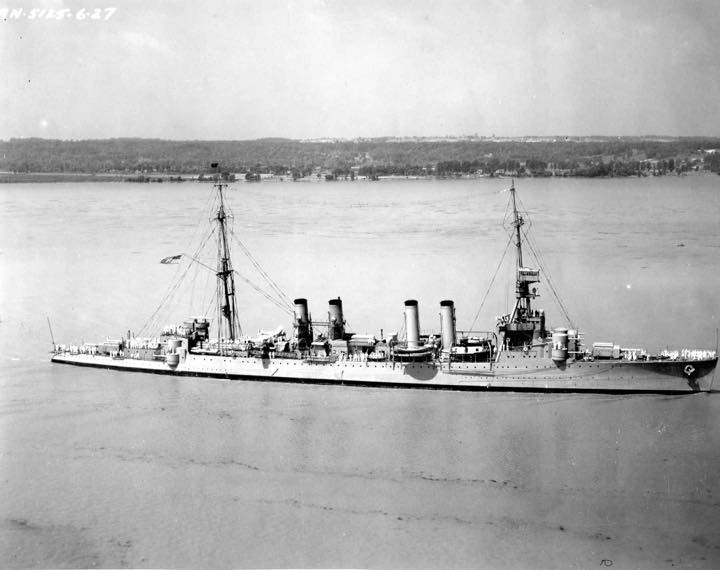USS Memphis CL-13

Memphis IV
(CL-13: dp. 7,050; 1. 555'6"; b. 55'4"; dr. 20'; s. 35 k.;
colt 790; a. 12 6", 7 3", 6 21" tt.; cl. Omaha)
Memphis (CL-13) was laid down by William Cramp & Sona, Philadelphia, Pa., 14 October 1920; launched 17 April 1924; sponsored by Miss Elizabeth R. Paine, daughter of Mayor Rowlett Paine of Memphis; and commissioned at the Philadelphia Navy Yard 4 February 1925, Capt. Henry E. Lackey in command.
Late in February Memphis got underway for a shakedown cruise in the Caribbean. On 13 April the cruiser participated in the dedication of an American memorial gateway to Commodore Oliver H. Perry at Port-of-Spain Trinidad. Six years after the indomitable Perry had defeated the British on Lake Erie 10 September 1813, he died on board frigate John Adams at Port-of-Spain and was interred there until his remains were removed to Newport, R.I., 7 years later. In June Memphis joined ships of a scouting fleet off Honolulu, Hawaii, for a cruise to the South Pacific through September, with visits to Australia and New Zealand. From October to April 1926 she again operated in the West Indies before returning to her home port, New York.
Memphis next sailed for Europe, arriving off St. Nazaire, France, 26 June. Relieving Pittsburgh (CA-4) as flagship of Commander, U.S. Naval Forces in Europe 4 July, she operated in European waters into 1927. During a stay at Santander, Spain, 31 July to 31 August 1926 the ship was visited by King Alfonso XIII.
On 3 June 1927 Memphis embarked Capt. Charles A Lindbergh and his plane at Southampton, England; following his nonstop flight from New York to Paris. The next day the cruiser departed Cherbourg, France, arriving Washington, D.C., 11 June to debark her famous passenger at the Washington Navy Yard. For the rest of the year she performed surveillance duty along the Atlantic coast.
During January 1928, Memphis acted as part of an escort group for President Calvin Coolidge on a cruise to the West Indies. After 4 months of Caribbean operations, she served in the eastern Pacific.
On 5 June the cruiser arrived at Balboa, Canal Zone for duty off Central America to May 1933. Memphis operated in a peacekeeping capacity at Corinto, Nicaragua, during the inauguration of President Juan B. Sacasa in 1932. In the next 5 years she alternated duty along the west coast with patrols to the troubled area of the West Indies.
After a good will cruise to Australia in January 1938, Memphis reached Honolulu 1 April to rejoin the fleet for operations until she participated in the presidential review off San Francisco 12 July 1939. In August she sailed to Alaska, operating there until early l941.
As the time of U.S. involvement in World War II approached Memphis sailed to the east coast. She departed Newport 24 April 1941 to take part in the neutrality patrol of the ocean triangle Trinidad-Cape San Roque-Cape Verde Islands, arriving Recife, Brazil, 10 May. She continued operations in the South Atlantic for most of World War II. In March 1942 the ship escorted two Army transports in convoy to Ascension Island, where the Army's 38th Engineer General Service Regiment debarked to construct an airport as staging point for planes flying from~ the United States to Africa. By May she was on patrol near the entrance to Fort de-France, Martinique.
In January 1943 the cruiser flew President Franklin Roosevelt's flag off Bathurst, Gambia, during the Casablanca Conference 14 to 24 January. The President and British Prime Minister Winston Churchill outlined plans at that time for the invasion of Sicily and Italy. From February to September, Memphis was once more on patrol duty against blockade runners, mostly off Bahin an
Recife, Brazil.
President Amenzoga of Uruguay and President Getulio Vargas of Brazil toured the ship in January 1944 while their countries continued to give valuable aid in blockading the "Atlantic Narrows." The following year Mem/phi. sailed for Europe, arriving Naples, Italy, 16 January 1944. On the 27th, as flagship for Adm. Harold R. Stark, Commander, U.S. Naval Forces in Europe, she got underway for Valletta, Malta, scene of preliminary Allied conferences prior to the Yalta Conference in February. Before the end of January the cruiser had two important
visitors: Fleet Adm. Ernest J. King and General of the Army George C. Marshall.
The 18th of February found Memphis at Algiers for President Roosevelt's last Allied conference before his return to the United States. The next 8 months she continued to receive distinguished leaders. She participated in the first anniversary ceremonies of the Allied landings at St. Raphael and St. Tropez, southern France, on the 18th of August and the Navy day festivities at Naples, Italy, the 27th of October. Late in November Memphis departed Tangier for Philadelphia, PA., where she decommissioned 17 December 1945. She was struck from the Navy list 8 January 1946 and sold to Patapsco Serap Co., Bethlehem, Pa., 18 December for scrapping following delivery 10 January 1947.
 >
>